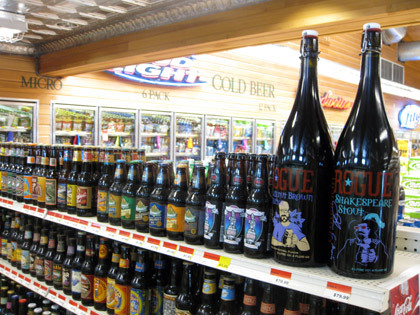As Alan nicely reported in close to real time (complete with a photo of our RV in case you’ve been wondering what our 140 square foot home looks like) our family spent a lovely evening with his last week. There was a lot of talk of beer — and a few beers were consumed — but also plenty about other things. Hang out with Alan and you quickly find out he’s led, and continues to lead, one heck of an interesting life. (You can also get a glimpse here.)
The conversation mix didn’t change when John Graham of Church-Key Brewing and Steve Beauchesne of Beau’s Brewing joined us, but I did learn that to be a small-batch brewer in Ontario you really got to want the job. They put up with a lot beyond taxes that make beer much more expensive than in the States an a myriad of regulations.
What struck me is both mentioned more than once who they are content with the size (small) of their breweries. I can’t tell you how many times during the past 15 years I’ve heard brewers say, “I don’t want to get that big, something like —- (fill in the blank with a brewery that is big — such as Sierra Nevada in the 1990s, now one like New Belgium or Deschutes) is all we are shooting for.”
There was none of that talk last week. Instead I heard about providing local customers with interesting choices, and more than once comments like one from Steve: “I just want to make enough beer to put my kids through college.”
I’m not saying that a brewery can’t grow larger, or sell its beer far from home, and still serve its local market. We can all come up with plenty of outstanding examples. (New Belgium and Deschutes would be among them.)
But I like the idea that the local guy is only local, hanging out at home in Ontario (in this case), talking to his neighbors about local beer that’s not going to be shipped anywhere else.
– Drinking in the real world. Last week in northern Vermont we visited cheese makers, a coffee roaster, a (maple) sugar house, an ice cream factory, and drank local beer (we wanted to take the funky Magic Hat tour I’ve read so much about but those are suspended because of construction). Each provoked thoughts about artisan production, ingredients and quality control.
Interesting to read Stonch’s post Sunday titled “Mass-produced beers – revisited” after those experiences.
I’ve spent the best part of three years seeking out obscure and interesting beers from around the world. I’ve tried almost every variety, from funky Belgian lambics to aggressive American DIPAs. Now I find myself applying more experienced taste buds and a better understanding of beer to mainstream products I temporarily dismissed out of hand. What I find are significant qualitative differences that demand attention.
Unless you’re happy to drastically restrict your options in terms of beers and the places you drink them in, then avoiding the produce of larger breweries simply isn’t possible. I’m less enamoured than ever with pubs that cater principally for beer enthusiasts, and you know what I think about beer festivals. In short, I want to live – and drink – in the real world.
I agree with him, but if I lived in Vermont the discussion could be moot.
– Remember Honey Amber Rose? It’s the one that was trademarked as “The first beer for women.” Its owners are going to try to sell the brand on eBay. This despite the fact the beer has been a wild success (their words). Does this story ring true for you? If so, go ahead and bid on that “200-year-old-secret recipe” for a low-calorie beer.
